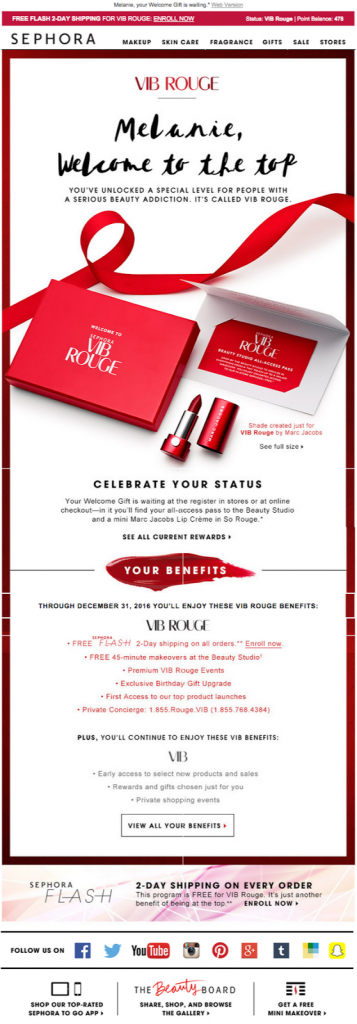I’ve got a bit of a breakthrough for you: Your current customers are your best customers.
Most business owners make the mistake of spending all of their time trying to get NEW customers, instead of focusing on serving their EXISTING customers.
I challenge you…
Instead of focusing on trying to get NEW customers, I want you to focus on creating NEW business this week.
How?
Well let me ask you something…
How many loyalty program cards do you have in your wallet right now?
My guess is every one of you has a few — from your grocery store “club card” right down to the the little punch card that gets you free frozen yogurt after your 8th cup. (Yay fro-yo!)
It used to be that these sorts of “gimmicks” were mostly for lower-end stores, but now high end brands including Nordstrom, J. Crew, and Sephora are implementing loyalty programs with some serious perks.
These companies know that repeat customers can be some of your BEST customers.
Sephora’s widely touted loyalty program is a perfect example of how a program can be on brand, on point, and deliver big business benefits.
If you’re interested in how a loyalty program might work for your business, I highly suggest you download my Free How to Build a Remarkable Rewards Program Guide. In it, you’ll find a host of tips and tricks to get your fan party started.
In the meantime, let’s look at how Sephora has crafted a winning loyalty strategy:
Win No. 1: Tiered Rewards
When you first sign up for Sephora’s rewards program, you’ll notice that there are three tiers, or levels, of membership:
- Beauty Insider
- VIB (Very Important Beauty Insider)
- and VIB Rouge
Beauty Insider is free to join, while the next two levels are unlocked with a certain level of spending: unlock VIB status by spending $350 in a calendar year, and unlock VIB Rouge status by spending $1,000 in a calendar year.
Each level includes different perks, gifts, and offers that align with the brand’s values and ideal customer. For example, Sephora knows that its customers are “beauty junkies,” eager to try the latest and greatest products, so some perks include new product samples, exclusive events, early access to sales, and more.
Tiered loyalty programs are one of the most effective ways to motivate desired behaviors from customers, and they are most effective when the upper tiers convey a true sense of exclusivity by having a limited number of members, usually only around 10 percent of the total customer base.
A little like the legendary American Express Black card, achieving Rouge status is difficult — and certainly not for everyone — but it is also attainable, and it lends a true sense of exclusivity. True fans covet this status and then brag about it to friends and followers. (Check out the #VIBRouge hashtag on Twitter, for example.)

Reaching these upper tiers makes customers feel like they’ve achieved elite status, and encourages others to strive to reach it.
The reason behind the psychology of tiered programs lies in the theory of gamification: when we offer customers rewards, it motivates their behavior — like leveling up in a video game.
But the rewards have to be in line with your brand.
Win No. 2: On-brand welcome gifts and points
Another way Sephora’s loyalty programs excel is with their on-brand rewards system.
It’s fine for your grocery store to offer coupons and discounts with your club card, but Sephora’s brand is all about luxury and exclusivity.
And let me just make this clear: Coupons and luxury do not match!
Sephora differentiates itself from other beauty brands by offering products that can be purchased with points. And these aren’t just drugstore beauty products, either; these are quality, high-end products from name brands. Offering high-end products for “purchase” with accumulated loyalty points is much more in line with the Sephora brand than offering discounts.
In addition, they offer free gifts tailored to a customer’s precise beauty concerns through their Beauty Profile. That way, 20-somethings don’t get samples of wrinkle cream and women fighting acne can sample clear skin products.
Other upper-tier rewards that fit perfectly with their brand include free beauty consults, free makeovers, discounted or free shipping, and an online “beauty bag” to track purchases and beauty product collections — for the serious beauty shopper.
All of this proves that Sephora knows their customers extremely well, but they want to know them even better…
Win No. 3: Customized promotional emails
Because Sephora’s loyalty program encourages shoppers to fill out their personalized “beauty profile,” the company can then deliver customized and personalized promotional emails.
Based on preferences and shopping history, Sephora can create pages and emails full of recommended products that they can be fairly certain a particular customer will want. The more data they can collect about a customer’s preferences, the more targeted their emails can become.
This is a sophisticated method of segmenting their list. Sending exactly the right email — and offer — to precisely the right customer dramatically increases the likelihood that those customers will open the email, click through, and make a purchase.
Apply these lessons to your brand
No matter what you sell, you can apply these lessons to creating your own brand loyalty program. For a winning program, remember:
- Use tiered reward levels for a sense of exclusivity.
- Keep rewards and freebies in line with your brand.
- And use the data you collect on your customers’ purchasing habits to craft targeted promotional emails.
If you think a loyalty program might be in your brand’s future, download our valuable free guide: How to Build a Remarkable Rewards Program.
It will definitely earn your brand points! 😉


